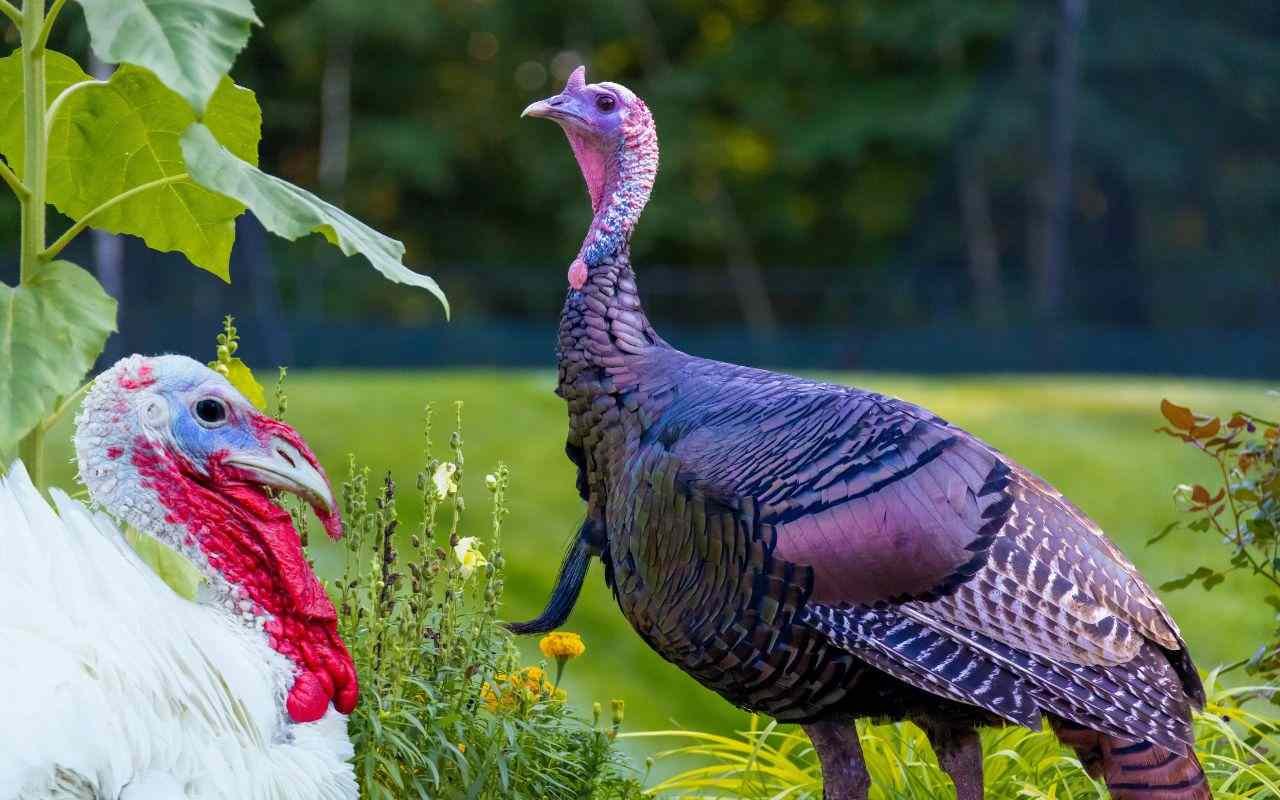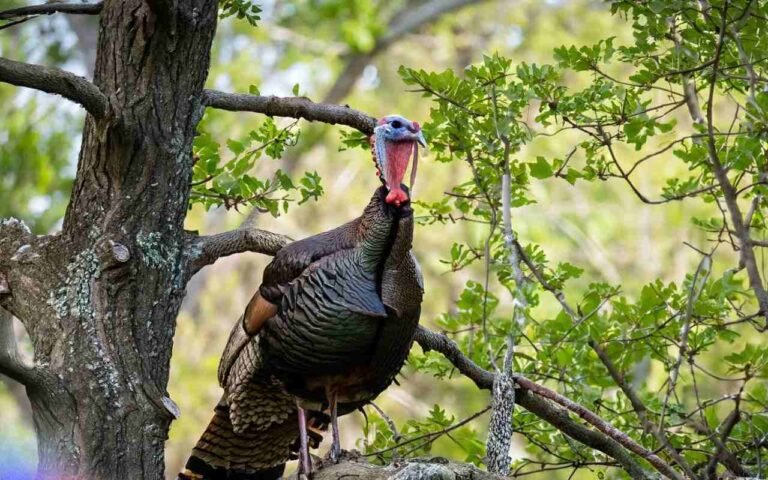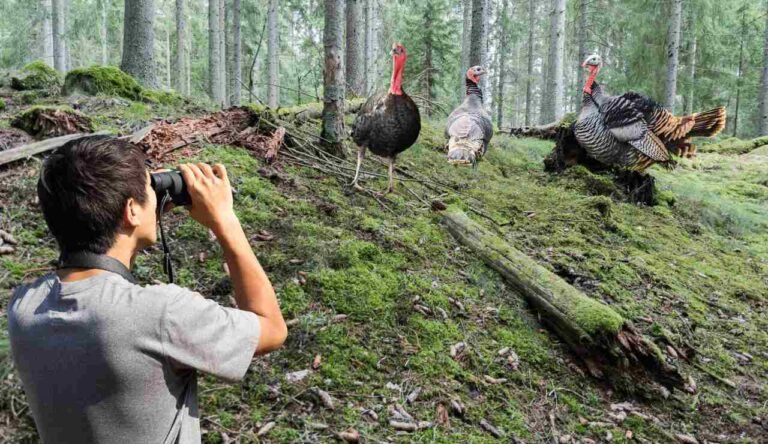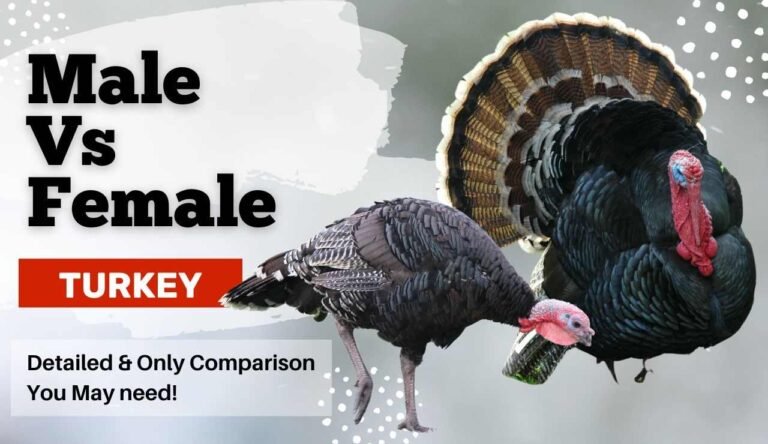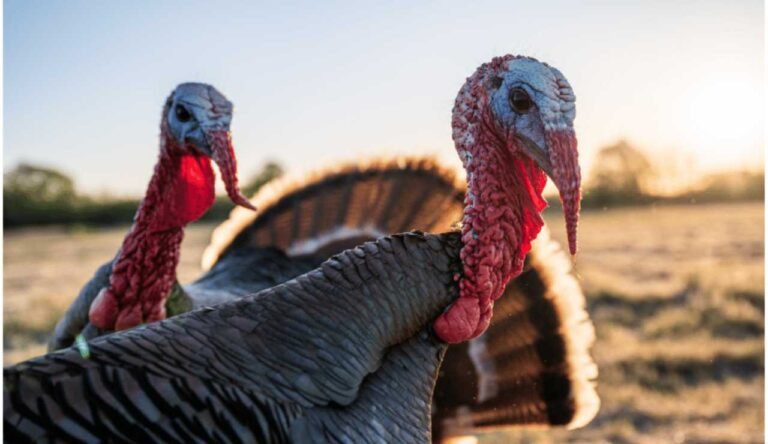Turkey Bird Types: A Comprehensive Guide- Unmasking Their Secret of Wild & Domestic Turkey!
Welcome to the fascinating world of many turkey bird species! Wild Turkey, North America’s most enormous game bird, and the Yucatán Peninsula’s Ocellated turkey have captivated birders and nature lovers worldwide. Read on to explore the six subspecies of the wild turkey and learn about the distinctive characteristics of each as we dig into the remarkable variety of turkey species. We’ll also learn about the fantastic domestic turkey breeds derived from their wild predecessors, each with unique characteristics and uses. We set out to discover the exciting variety of turkey bird varieties as we dig into this skillfully created article, enjoying their beauty, mannerisms, and distinctive traits.
Wild Turkey: A World of Wonder
The wild turkey personifies the woods’ untamed spirit with its pride strut and alluring fan-shaped tail. The cherished wild turkey, a native of North America, is renowned for its magnificent plumage and enormous size. The Eastern wild turkey (Meleagris gallopavo silvestris), one of several species, is the most well-known and widespread. However, the immensity of the outdoors is home to various wild turkey species worthy of our admiration.
Specifications of the Wild Turkey Species
| Wild Turkey Species | Courtship Display | Habitat Preference | Social Behavior |
|---|---|---|---|
| Eastern Wild Turkey | Strutting with Fan-shaped Tail | Forests, Woodlands, Meadows | Often Form Large Flocks |
| Osceola Wild Turkey | Strutting with Fan-shaped Tail | Cypress Swamps, Pine Woods | Less Tolerant of Human Presence |
| Rio Grande Wild Turkey | Strutting with Fan-shaped Tail | Open Country, Brushy Areas | Roost in Trees or Elevated Sites |
| Merriam's Wild Turkey | Strutting with Fan-shaped Tail | Mountainous Regions | Gather in Loose Flocks |
| Gould's Wild Turkey | Strutting with Fan-shaped Tail | Mountainous & Arid Regions | More Elusive and Shy |
Comparison of Wild Turkey Species
| Wild Turkey Species | Scientific Name | Range | Plumage Colors |
|---|---|---|---|
| Eastern Wild Turkey | Meleagris gallopavo silvestris | Eastern United States, Canada | Copper, Bronze, Green |
| Osceola Wild Turkey | Meleagris gallopavo osceola | Florida, Southern Georgia | Black, Copper |
| Rio Grande Wild Turkey | Meleagris gallopavo intermedia | Southwestern United States | Brown, Bronze |
| Merriam's Wild Turkey | Meleagris gallopavo merriami | Western United States, Mexico | Silver, Brown |
| Gould's Wild Turkey | Meleagris gallopavo mexicana | Northern Mexico, Southwestern U.S. | White, Black, Bronze |
How Many Species of Wild Turkey Exist?
There are six species of wild turkey, each with distinct traits and geographic ranges. The most well-known and ubiquitous species may be found in the eastern United States and Canada, and its scientific name is Meleagris gallopavo silvestris. The Rio Grande wild turkey (Meleagris gallopavo intermedia) roams the Southwestern United States, while the Osceola wild turkey (Meleagris gallopavo osceola) flourishes in Florida and Southern Georgia. The Merriam’s wild turkey (Meleagris gallopavo merriami) lives in the mountainous areas of the western United States and Mexico, whereas the Gould’s wild turkey (Meleagris gallopavo mexicana) inhabits Mexico and certain areas of the southwestern United States. The only species found in the Yucatán Peninsula in Mexico not native to North America is the ocellated turkey (Meleagris ocellata).
Eastern Wild Turkey – The Emblem of Resilience
The Eastern wild turkey, the most prevalent species of wild turkey, rules over a vast area stretching from the forests of the eastern United States to isolated areas of the Midwest. These birds fluidly travel various surroundings, quickly adjusting to different settings, and have rich, black plumage with stunning radiance. With their enthusiastic gobbling cries reverberating through the forest, Eastern wild turkeys have come to represent resiliency and flexibility in the face of environmental problems.
Osceola Wild Turkey – The Enigmatic Floridian
The Osceola wild turkey stands out among the different species as a sought-after discovery for birdwatchers and hunters. These birds, native to Florida, have stunning patterns and brilliant colours. They have a strong love for the rich environments of the peninsula, which reflects their prowess in the varied ecosystems of the Sunshine State. Many people find great joy in seeing an Osceola turkey in its natural environment because it gives them a chance to appreciate the mysterious beauty of the Florida forest.
Rio Grande Wild Turkey – A Vision of the Southwest
The Rio Grande wild turkey invokes ideas of untamed beauty with its fascinating habitat that ranges from the arid plains to the brushy forests of the Southwest United States. The Rio Grande turkey, which has a duller plumage than its Eastern cousin, fits well with the arid landscape, a monument to nature’s craftsmanship. You may see a symphony of life intermingled with the arid yet stunning landscapes of the Southwest by watching these birds in their native environment.
Merriam’s Wild Turkey – The Mountain Majesty
The Merriam’s wild turkey asserts its dominance in the western United States’ steep highlands. These mountain residents perfectly represent the appeal of high-altitude habitats, with silver-tipped feathers that glitter like snowflakes in the sunshine. A flock of Merriam’s turkeys can be seen moving gently over alpine meadows, demonstrating their ability to adapt to difficult conditions and live in harmony with nature’s magnificent creations.
Gould’s Wild Turkey – The Mexican Gem
We come across the Gould’s wild turkey as we go south of the border; this rare bird is primarily found in the far northern regions of Mexico and specific areas of Arizona and New Mexico. This subspecies, which bears J. Gould’s name, charms with its stunning contrast of white and black feathers. Gould’s turkey represents the beauty of uncharted places and the significance of protecting these unknown treasures by embodying the charm of the Mexican wilderness.
Breeds of Domestic Turkey
There are several domestic turkey breeds available to suit different requirements and interests. Each breed has something distinctive to offer, from the Broad Breasted White, prized for its vast size and meat output, to the aesthetically appealing Bourbon Red with its superb taste. Heritage breeds like Narragansett, Royal Palm, and Standard Bronze are excellent options for anyone looking for more than meat production since they combine endearing personalities with solid foraging skills. The White Holland breed is a fantastic alternative for individuals looking for egg-laying qualities because of its high egg output.
| Breed | Key Attributes | Main Purpose |
|---|---|---|
| Broad Breasted White | Large size, white feathers | Meat Production |
| Bourbon Red | Beautiful red plumage, excellent flavor | Meat Production |
| Narragansett | Calm temperament, good foragers | Flavorsome & Meat |
| Royal Palm | Striking plumage, good foragers | Flavorsome & Meat |
| Standard Bronze | Large size, dark plumage | Good for Meat |
| White Holland | White feathers, good egg production | Egg-Laying & Meat |
Each breed has unique qualities that make them appropriate for various uses and preferences. Turkey enthusiasts may discover the ideal match among these domestic turkey varieties, whether they choose a considerable turkey for producing an abundance of meat or a heritage breed with a kind attitude. Whatever option you choose, these endearing birds provide beauty and function to farms and homesteads.
Comparison of Domestic Turkey Breeds for Meat Production
| Breed | Average Weight (lbs) | Meat Flavor | Foraging Ability |
|---|---|---|---|
| Broad Breasted White | 25 - 45 | Excellent | Moderate |
| Bourbon Red | 20 - 30 | Excellent | Good |
| Standard Bronze | 25 - 35 | Good | Excellent |
Conservation Initiatives
Despite their widespread existence, some wild turkey species have had difficulties because of habitat degradation and hunting. Conservation groups greatly aid the protection and preservation of these unique species for future generations. By aiding these initiatives, we can ensure that the wide variety of turkey bird species live on in the wild and win our hearts.
Conclusion
Finally, examining turkey bird kinds has been fascinating. From the stately Wild turkey, North America’s wilderness emblem, to the vivid and enticing Ocellated turkey of the Yucatán Peninsula, each species has a wonderful narrative. The six wild turkey subspecies, from the Eastern wild turkey to the Rio Grande wild turkey, demonstrate these interesting birds’ flexibility and persistence. Domestic turkey varieties evolved from their wild progenitors have a variety of traits and uses, making them important to human history and agriculture.
Frequently Asked Questions
What are the different types of turkey birds?
There are two turkey species: the wild turkey (Meleagris gallopavo) and the ocellated turkey (Meleagris ocellata). North America’s wild turkey has six subspecies:
- The Eastern wild turkey
- Osceola wild turkey
- Gould’s wild turkey
- Merriam’s wild turkey
- Rio Grande wild turkey
- The Yucatán Peninsula’s Ocellated turkey
Domestic turkeys, descendants of wild turkeys, are breeds. The Broad Breasted White, known for its large size and meat production, Bourbon Red, Narragansett, Royal Palm, Standard Bronze, and White Holland are popular domestic turkey breeds. Turkeys are intriguing because of their many kinds and breeds.
How many wild turkey species are there?
There are six different species of wild turkey; the only one not indigenous to North America is the ocellated turkey, located on the Yucatán Peninsula of Mexico. The other five species—the Eastern wild turkey, the Osceola wild turkey, the Gould’s wild turkey, the Merriam’s wild turkey, and the Rio Grande wild turkey—are all indigenous to North America and may be found in a variety of environments, including woods, grasslands, and deserts. These many turkey species are fascinating subjects of study and adoration for bird enthusiasts and nature lovers due to their distinctive charms and essential roles in their different habitats.
What distinguishes domestic turkey breeds from wild turkey species?
The traits and habitats of wild turkeys and domestic breeds are where the main differences between the two reside. Wild turkeys are adaptable to various natural habitats and endemic to some regions of North America. They have longer legs, more streamlined bodies, and colorful plumage with iridescent feathers. The opposite is true for the domestic market, where the majority of the time, the same is true for the majority of the time. They often have a wider variety of colors and patterns since they are cultivated on farms.
Are all wild turkey species endangered?
Not all wild turkey species are threatened, however. While habitat degradation and hunting may pose problems for specific subspecies in terms of conservation, other subspecies maintain stable populations. For instance, there are many Eastern wild turkeys, and they are intensively controlled for conservation and ethical hunting. To preserve the survival of all turkey bird species, it is imperative to maintain funding conservation efforts.
Can domestic turkey breeds survive in the wild?
Most domestic turkey breeds need to be better adapted for wilderness survival. They rely on human care and protection since they have been deliberately bred over many generations for certain qualities. Domestic turkeys may have difficulty locating food, avoiding predators, and adjusting to their natural surroundings if released into the wild. Domestic breeds must be kept in carefully regulated settings where their unique requirements may be addressed.
What distinguishes the Osceola wild turkey from other species?
Native to Florida and some of southern Georgia, the Osceola wild turkey is sometimes called the Florida turkey. It sticks out because of its eye-catching black and copper feathers with white tips. Osceola turkeys have adapted to the subtropical temperature of the area and seek habitats like cypress swamps and piney woodlands. They are highly sought after by both hunters and birdwatchers because of their restricted range.
How can I determine the gender of a wild turkey?
Wild turkeys, usually called toms and hens, may be distinguished based on specific traits. Male turkeys generally have bigger bodies, longer beards (chest hairs), and more pronounced tail fans. Toms have vivid colors on their heads and wattles during the breeding season. Female turkeys are often smaller and have fewer colorful feathers. Determine their gender by observing their actions and vocalizations.
Are all domestic turkey breeds suitable for meat production?
Not all domestic turkey breeds are equally well-suited for meat production, even though many are. Some varieties, like the Broad Breasted White and Broad Breasted Bronze, were developed primarily to provide an abundance of meat because of their size. Other breeds, such as the Royal Palm and Bourbon Red, may be less productive for producing large quantities of meat since they are often retained for decorative and historical reasons.
What role does wild turkey conservation play?
Wild turkey conservation is essential to sustain biodiversity, protect natural habitats, and ensure ecological balance. These birds aid in seed dissemination, pest management, and plant growth—all essential elements of a balanced ecology. The sustainability of turkey populations is also supported by hunting restrictions and conservation initiatives, enabling future generations to enjoy the beauty and grandeur of these iconic birds.
- Louisiana Turkey Season 2026: LA Turkey Hunting [Dates, Regulations, Licenses & More] - January 5, 2026
- Kentucky Turkey Season 2026: Latest Hunting Dates, Regulations & Licenses! - January 5, 2026
- Kansas Turkey Season 2026-2027: Latest Dates, Licenses, and Regulations Now Available! - January 3, 2026
